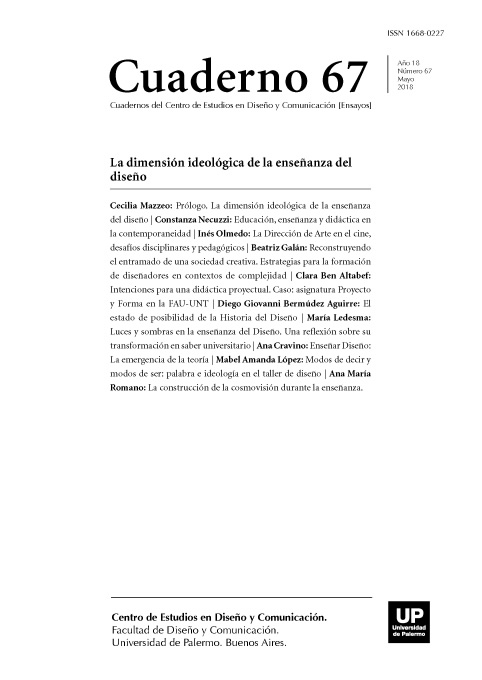La Dirección de Arte en el cine, desafíos disciplinares y pedagógicos
Abstract
Present in the cinema from Meliés, the physical sustenance of the cinematographic image involves multiple knowledges, capacities and projects and production experiences that have not always been credited in the works. His academic approach at university level is just twenty years long, and we are talking about a discipline that is born next to the cinema. Many factors, prejudices and ideological aspects now find an opportunity to revert from the field of training spectators and designers, thanks to the need to systematize and integrate this knowledge and experience of practice with the conceptual approaches that give them meaning It is necessary to elaborate contents and pedagogical strategies that respond to the need to train designers capable of adding value to audiovisual projects.
References
Aumont, J. (1992). La Imagen. Barcelona: Ed. Paidós.
__________. (1997). El ojo interminable. Barcelona: Ed. Paidós.
Bazin, A. (2008). Qué es el cine. Madrid: Ed. Rialp SA.
Bonitzer, P. (2007). Desencuadres, Cine y pintura. Santiago Arcos Editor.
Chateau, D. (2010). Estética del Cine. La Marca Editora.
Ettedgui, P. (2002). Diseñadores de producción, Dirección de Arte. Ed. Océano.
Jimenez, J. (2004). Teoría del arte. Madrid: Alianza Editorial.
Gardies, R. (2014). Comprender el cine y las imágenes. La Marca Editora.
Landis, D. (2014). Diseñadores de vestuario. Ed. Blume.
Lo Brutto, V. (2002). Guide to Production Design. Ed. Paperback.
Ranciere, J. (2012). El reparto de lo sensible, estética y política. Ed. Prometeo.
Rizzo, M. (2005). The Art Direction Handbook for Film. Ed. Focal Press.
Tashiro, C. S. (1998). Pretty Pictures: Production Design and the History Film. Ed. University of Texas.
Ward, P. (1994). What an Art Director Does: An Introduction to Motion Picture Production Design. Ed. Paperback.
Whitlock. C. (2010). Designs on Film: A Century of Hollywood Art Direction Hardcover. It Books.
Yoel, G. (comp.) (2004). Pensar el cine 2.- Cuerpos, temporalidad y nuevas tecnologías. Ed. Corregidor.
Los autores/as que publiquen en esta revista ceden los derechos de autor y de publicación a "Cuadernos del Centro de Estudios de Diseño y Comunicación", Aceptando el registro de su trabajo bajo una licencia de atribución de Creative Commons, que permite a terceros utilizar lo publicado siempre que de el crédito pertinente a los autores y a esta revista.


